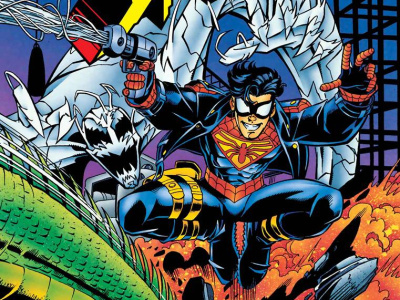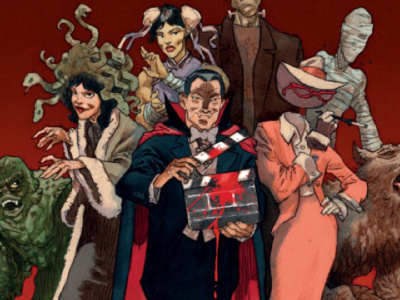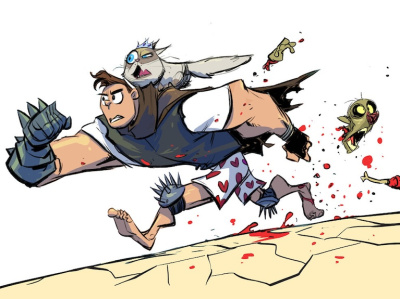A couple of weeks ago at the San Diego Comic-Con, we sat down with a delegation from ICE Kunion, the new Korean consortium that was formed to bring Korean comics to the American market (see 'Korean Consortium Leads Manhwa Charge'). Erik Ko, Chief of Operations at UDON, and Charles Park, Editorial Manager there, were the North American contingent; Jeong-hyun Chin, Publication Dept./Director of Sigongsa, and Ju-youn Lee, Studio ICE editor from Sigongsa were the Korean representatives. In Part 1, we talk about the decision to enter the U.S. market directly, rather than continue to work through licenses. In Part 2, we discuss the pace of the launch, the target audience, and the nature of the Korean comics market. And in Part 3, we discuss the path of Korean intellectual property development and the relationship between UDON and the Korean publishers.
Tell us about the decision to come into the American market directly, rather than work through licensees. What do you feel you can accomplish directly that you couldn't do working through licensing your materials to other publishers?
Park: Same thing with Japanese publishers. When they license their product they have a sense of parenthood of their products. All their artists and editors work as hard as possible to make the product as perfect as you can possibly make it. American adaptations have been different than they envisioned for a number of reasons. From the publisher's side they have to think of financial issues, logistics. Some markets adapt in a different way. The market has matured. People look for more authentic adaptations. It's not simply a comic from somewhere else anymore. It's more of a cultural experience. People are reading Japanese manga not because it's Japanese manga. It's a cultural phenomenon. They want to know more about Japan. They study Japanese. They are fascinated by Japanese culture.
The audience has gotten to the point where they're looking for more authentic adaptations and introductions. That's the reason we decided to bring them a little bit closer to what's actually going on in Asia. A lot of times adaptations are done by different publishers. Schedules get pushed for a number of different reasons. Title selections are different because of financial decisions and different reasons. The major thing we want to push, our material is newer. It's what's going on in Asia right now. We're trying to introduce these materials ourselves as a creator. We're introducing these particular materials the way they should have been. That's our intention.
Ko: The major emphasis here versus what licensed comics are doing is we have more control. We can select better titles to showcase manhwa to reading fans who are interested in the Asian culture. We can show them the best things we have. The most current and hot titles we can bring in almost simultaneously as long as we schedule it right and everything. There's practically no time left that we can actually do it to that point versus when we used to license the titles to a lot of publishers here. Sometimes because of a conflict in scheduling some titles got pushed back, some titles did not get picked up because the guy doesn't like certain things or the price isn't right. There's a lot of reasons. We're basically doing a creator-owned Korean manhwa here. For regular comic-book reading people it's a creator-owned project.
Timing and title selection, we understand the rationale. The other part we heard you say was that you felt past adaptations were not faithful to the original.
Park: They tried to be faithful as much as possible. But it would not be as faithful as if the creators themselves were doing it. That's our main focus. Particular the shoujo line, particularly girl comics. Their stories tend to be a lot more down to earth. They tend to be a lot more about their experiences, their lives, and what's going on with their audience's lives. That's one of the reason the shoujo line has been so successful in America. American comics never had a female audience before. But the new group of fans loves to be connected to the author's experience. When the adaptation was done by other people there were other factors that had a lot more importance than the integrity of the product. I wouldn't necessarily say unfaithful. We know that they tried to their best. We believe if creators are involved it will be more authentic. It would be done closer to what it's supposed to be.
Ko: Our idea is to connect the creators with the readers. You'll see the difference with our books because they are more of a creator-owned thing. We can put more materials in it. We'll include interviews with the creators as to what kind of message the creator wants to give to the audience, or maybe show why they like to do this title. There's a lot of more sentimental connections to it, especially for the shoujo market, for the female readers. Male readers are looking for visual excitement. Female readers are more sentimental. They're more involved with the stories, what the characters are doing. They try to find a connection, an attachment to it. Korean manhwa is very strong. It has a great strength to it.
We want to ask about the terminology. Korean comics in the U.S. have been called a number of things, spelled a number of different ways. We've standardized our use over the past year to m - a - n - h - w - a. I've also seen manwha. Some people just call it Korean manga. I'm curious about your decision in your release and for your launch to use manhwa. Why was that choice made, and how do you feel about calling it manhwa versus manga?
Ko: It's the same thing. I myself do comic books. When we did our first book, the experience we had was, are we doing a comic, or are we doing a manga? When we talk about launching this, what are we going to call this? I've been having friendly discussions online with a lot of people about this. Essentially it's the same word. It means comics. Manga, manhwa, no matter how you spell it... How the Koreans do it is hwa. It's not always the same, it's just slightly different phonetics. If you look at it, it's all written the same. All the Asian people read the same two words. It means comics. It's just comics. It's the difference between Kleenex or tissue paper. They brand this thing. A lot of people say, 'you have a Kleenex?' They mean do you have a tissue paper. It's kind of like now when they brand manga as Japanese comics, because it's a format. It's black and white, it has more pages than the standard American comic. That's how they do it. We feel a distinguished difference between Korean content and Japanese content. They're similar enough, but deep down there are many differences. I think Japanese manga is more catering to the commercial market. I know a lot of Japanese creators and they always talk to me about, 'I really want to do this project, but I have two other projects first. The editor wants me to put more panty shots in there, more sex.' I know for a fact that happens in Japan. But in Korea the editors work with the creators to see what they want to do. The creators only like to do things that they're personally attached to. The creators feel like a call out to the readers as to their personal experience of this particular subject.
We understand all those words however spelled mean comics. So why did you make the choice manhwa?
Lee: This was decided by the Korean government.
Ko: I don't know if you know the booth over there, it's actually a government paid project. The Korean government is very into promoting comics as a medium, not as something that's just for kids. They're very involved. This particular spelling is official.
Your licensees have sold a fair amount of Korean material over the last few years. Can you give us an estimate of the total number of volumes of Korean material published in the States to date? What percentage of those volumes does this consortium represent?
Lee: There are four major Korean publishers. Most of them came from these publishers.
Would it be safe to say that over eighty per cent of what's been published here has been from these four?
Park: Probably a hundred per cent. They all came from four major empires. Our company is the joint project of two of them.
Do you have an estimate of the total number of volumes that have been published over here?
Ko: It's probably in the hundreds.
Park: We'll have to ask our partners.
Ko: We're talking about a couple hundred titles that have been mixed up in the Japanese manga market already. People are starting to feel the presence.
Park: Not everything has been published just yet. The licenses that have been sold are probably in hundreds. Not everything has come out yet.
Are those series all complete under the publishers that have the licenses now?
Ko: Most of those are done deals. We're doing some ongoing titles that most publishers won't even look at. Most publishers want to see how many books are there, how much it is. With us, our major concern is what's good to bring over here.







